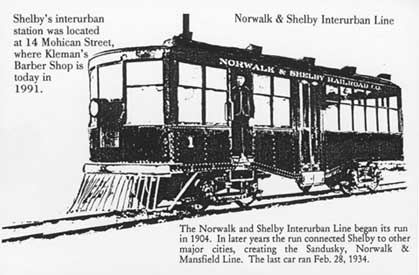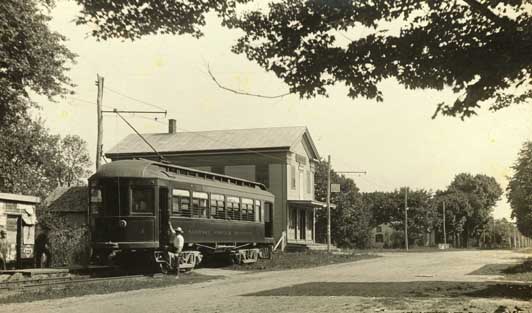
- - - -
Shelby Interurban - - -
-
- In
1901, the street car line of the Citizen's Electric Light &
Power Co. of
- Mansfield,
Ohio started the construction of an interurban rail line to Shelby.
- It
was located along the west side of the existing Baltimore &
Ohio railroad.
- It
passed through Spring Mill and continued northwest on to Shelby.
- Entering
the south edge of Shelby, the line continued along the west side
- of
the B & O railroad until reaching Tucker Ave. where it turned
to follow
- High
School Ave. and then on along the Blackfork to 14 Mohican Ave
- where
the station was located.
-
- By
1907, after financial difficulties and several owners, this line
was
- eventually
purchased by the Cleveland Southwestern Co.
-
-
- A
rail route between Norwalk and Plymouth was established in 1903/04.
- A
branch was completed from New Haven to Willard and one was planned
to
- continue
from Plymouth to Shelby. Before this branch was finished, the
- company
ran out of money and it wasn't until 1904/5 that the line
- was
completed to Shelby.
-
-
- Post
Card courtesy of the Shelby Museum
-
- Interurban
Post Card - Norwalk & Shelby Car # 1
-
-
- By
1907, there were cars running the route extending from Norwalk
through
- Shelby
to Mansfield. The schedules and fares of the runs were published
in the
- Shelby
Globe. After another change of ownership the line was succeeded
- by
the Sandusky, Norwalk, and Mansfield Railway. Efforts were made
- to
allow cars of one line to run directly on both rail lines, thereby
- eliminating
wait overs to change from one line to another.
-
-
-
- photo
ca. 1911 - courtesy of Phyllis Frazee
- Sandusky,
Norwalk, and Mansfield, Station in New Haven, Ohio
- (The
building in the photo is on the east side of Rt. 61, a few blocks
north of Rt. 224)
-
-
- In
1909, a Mansfield passenger could ride the interurban car to
Shelby on the
- Mansfield
to Shelby branch of the Cleveland, Columbus, & Southwestern
- and
then wait about 1/2 hour until a car from the S, N, & M line
would arrive.
- Upon
reaching Norwalk, the passenger could continue on to Sandusky
- only
by using a connection with the LakeShore main line running
- between
Toledo and Cleveland.
-
-
- To
this date, the cars used by the rail lines were all electric
powered and took
- the
power off of an overhead line in the manner of a trolley car.
The line north
- of
Shelby was powered by a electric generating station in North
Fairfield, which
- is
located due south of Norwalk at the point where the rail line
turned and ran
- due
west for a short distance before continuing south to New Haven.
-
- As
the rail lines expanded and the number of cars increased, the
power
- requirements
grew and these smaller generating stations could not supply
- sufficient
power for the lines. The Southwestern Co. generators supplied
- power
to many smaller rail lines until they ran up bills so large they
could
- not
pay. At this point the smaller company must sell or acquire financing
- from
another source. Many of the changes of ownership were due to
- factors
such as these.
-
- The
peak years for the interurban service were those just prior to
and including
- the
WW I years. After WW I, the interurban railways began to get
increasing
- competition
from automobiles, buses, and trucks. The profitability of the
- rail
lines began to drop and services were reduced. The lines servicing
- Shelby
went into receivership several times during the years from 1912
to
- the
beginning of WW I. The power bills were the cause of major concern.
- Finally
in 1921 the Southwestern Co. turned off the power to the
- S
N & M railway. The service was shut down for about 6 months
until two
- gasoline
powered cars were purchased from the American Railway Motor Co.
- in
Elyria for use on the line.
-
- On
December 22, 1922 the first gasoline car left Norwalk for the
trip over
- the
line through Shelby to Mansfield. The cars were 35 feet long
and could
- carry
40 people at a top speed of 40 mph. The engine generated electricity
- for
lighting purposes, interior and exterior, had airbrakes, air
whistle,
- sanders
and all the modern improvements.1
-
- These
cars were readily accepted by passengers, but more people were
using
- other
means of transportation and ridership continued to decrease as
the years
- passed.
The year 1934 was the end of the interurban era for the Shelby
area....
-
-
- 1
This paragraph
abstracted from a
Daily Globe
article dated Dec. 22, 1922
- If you would be
interested in adding to, or commenting on the items on this page,
- please contact
us.


Copyright
© 2000 - 2025









